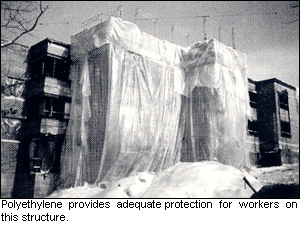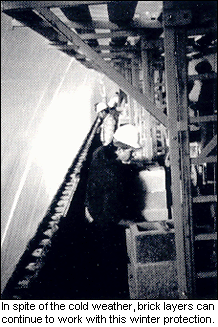Hot & Cold Weather Masonry Construction
Protection
 General. An enclosed construction site maintained at a temperature greater than 40°F (4.4°C) is ideal for cold weather masonry construction.
General. An enclosed construction site maintained at a temperature greater than 40°F (4.4°C) is ideal for cold weather masonry construction.
Economics, however, dictate how elaborate the protection can be, whereas ambient temperature dictates when the protection is needed or when work stoppage should be enacted. A balance between mason productivity and structure protection is required. Because each case is different, specific procedures should be designed for each particular job. The range of protection may go from a simple windbreak to a completely enclosed structure.
The tops of all walls not otherwise protected should be covered with a weather resistive membrane extending a minimum of 2 feet (0.6 m) down on both sides to prevent water from entering the masonry.
Types. Enclosures and windbreaks are temporary and therefore are designed to fit the particular job. They can range in size from a single insulation blanket to an elaborate shelter which protects the entire work area. Factors to be considered in selecting the type of protection:
- Type of building and its design
- Type of scaffolding used
- Masonry work under construction
- Severity of the weather
Materials commonly used for protection are canvas and synthetic coverings (reinforced polyethylene and vinyl).
The ingenuity of the individual contractor is exhibited by the use of other materials for protection. Such characteristics as strength, durability, flexibility, transparency, fire resistance, and ease of installation should be considered when selecting protection material.
 In most instances, an unheated enclosure reduces the effects of temperature plus wind and provides the degree of protection that is adequate for masonry construction. The enclosure, heated or unheated, should protect the structure from early freezing, and if heat is applied, from rapid mortar dry-out.
In most instances, an unheated enclosure reduces the effects of temperature plus wind and provides the degree of protection that is adequate for masonry construction. The enclosure, heated or unheated, should protect the structure from early freezing, and if heat is applied, from rapid mortar dry-out.
Safety. Workers responsible for installing protection must have a full knowledge of the scaffolding being used, and how to properly erect, adjust, brace, anchor, and dismantle the complete assemblage. The protection must provide measures to safeguard the worker from injuries caused by high winds, fires, and air contamination. Scaffolding must be properly erected, braced and anchored so that the assemblage is safe from snow and wind loads and lift.
Summary. Enclosures and windbreaks should be designed for the particular structure using locally available materials. For the method of installation, the contractor's ingenuity will generally prove adequate. Enclosures and windbreaks must be designed with consideration of both protection of the structure and safety of the individual worker.
Return to Hot & Cold Weather Masonry Construction